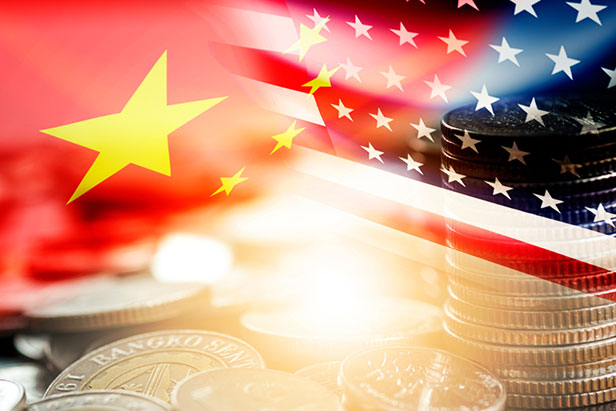October 28, 2019
Trump Heralds Progress in US/China Trade Deal
Chinese officials have characterized the agreement as “basically completed.” This could be good news for the promotional products industry, though all current tariffs remain in place.
President Donald Trump said Monday that the crafting of a written agreement establishing “Phase One” of a new U.S./China trade deal was progressing ahead of schedule – comments made just a day after officials in Beijing characterized the first Phase One deal as “basically completed.”
The reported progress carries importance for the domestic promotional products industry, which has grappled with everything from product price increases and market uncertainty to supply chain disruption as a consequence of import tariffs imposed during the more-than-year-long trade war between the world’s two largest national economies.

“We are looking probably to be ahead of schedule to sign a very big portion of the China deal, we’ll call it Phase One, but it’s a very big portion,” Trump told reporters Monday morning. “That would take care of the farmers. It would take care of some of the other things. It’ll also take care of a lot of the banking needs.”
Late last week, U.S. Trade Representative Robert Lighthizer, Treasury Secretary Steven Mnuchin and China’s Vice Premier Liu He held talks on the Phase One deal. According to a statement from China’s Ministry of Commerce, both sides “agreed to properly resolve their core concerns and confirmed that the technical consultations on some of the texts were basically completed.”
On Oct. 11, Trump announced that the U.S. and China were poised for a Phase One deal. Negotiators from both countries have been working to establish the legal text for the agreement. It’s possible Trump and Chinese President Xi Jinping could sign the deal at the Asia-Pacific Economic Cooperation Summit, being held in November in Chile.
The reported progress on trade talks and strong earnings reports helped fuel the S&P 500 to an all-time high on Monday morning. The S&P 500 rose 0.6% to trade above 3,027.98 – the record set on July 26. The Dow Jones Industrial Average increased 0.4%, or 104 points, while the Nasdaq Composite rose 0.9%.
BREAKING: S&P 500 hits new all-time high at the openhttps://t.co/bAWBc91cmb
— CNBC Now (@CNBCnow) October 28, 2019
1. S&P 500: +22.5% year-to-date, at all-time high.
— Charlie Bilello (@charliebilello) October 25, 2019
2. Unemployment Rate: 3.5%, 50-yr low.
3. Economic Expansion: 123 months, longest in history.
4. Jobs Growth: 108 straight months, longest in history.
5. Core CPI: 2.4%, 11-year high.
6. Fed: cutting rates for 3rd time next week.
Promotional products executives have expressed guarded optimism over the U.S./China trade talks, characterizing the apparent movement forward as encouraging but nothing to celebrate yet. “On balance, it’s definitely more positive than negative, but multiple uncertainties still exist,” Eddie Blau, CEO of Top 40 supplier Innovation Line (asi/62660), recently told Counselor.
“It’s too early to tell what this means until the deal has been signed and sealed,” Shamini Peter, chief operating officer at Top 40 distributor Axis Promotions (asi/128263), told Counselor. “Based on past practice, there’s always a possibility of this going back to the drawing board. Given that the U.S. and China are giants and have the ability to directly impact the global economy, the two presidents have to find a balance in the deal.”
According to various press reports, the Phase One deal could contain agreements on important issues, including agricultural purchases, intellectual property and financial services. Last week, China passed a law that promises intellectual property protections for foreign companies operating in the country. The Trump administration has insisted that Beijing stop its practice of forcing U.S. companies and other foreign firms to transfer trade secrets/intellectual property as a condition of doing business in China. As for agriculture, reports have suggested that China is willing to increase its purchases of U.S. agricultural products, a key emphasis for the American side. Still, China might only be prepared to do so if the U.S. cancels some of its existing tariffs on Chinese imports.
Trump postponed a planned Oct. 15 increase of the tariff rate on $250 billion in Chinese imports from 25% to 30% after the Phase One progress was announced. Still, as of Oct. 28, the U.S. administration has plans to implement tariffs of 15% on a little less than $200 billion in additional Chinese imports on Dec. 15. Whether or not that will happen remains uncertain, especially if trade talks go well. U.S. duties of 15% that went into effect Sept. 1 on $112 billion in China-made products continue to be active.
The tariffs have proved problematic for the U.S. promotional products industry, which imports the majority of the items it sells stateside from China. Duties have – or are poised to – affect product categories that range from T-shirts and headwear, to drinkware and technology items.
As a result, the promo industry has faced issues that include increased product prices, destabilized annual pricing, challenges in producing catalogs and an ever more uncertain selling environment that some fear could cause end-buyers to reduce their spending on ad specialties. The trade conflict has also made longer-term planning more difficult for some suppliers and caused suppliers (and certain distributors that source direct from abroad) to increasingly look beyond China to produce products. As the search for new sourcing destinations accelerates, some industry leaders worry that more product safety and social responsibility issues will arise.